#ultraman 1996
Explore tagged Tumblr posts
Text

Ultraman Infographic from The Straits Times Newspaper 18 December 2021.
#ultraman#infographic#tsuburaya productions#ultra series#japan#tokusatsu#ultraseven#ultraman ace#ultraman taro#ultraman tiga#ultraman nexus#ultraman ginga#ultraman x#ultraman orb#ultraman z#ultraman trigger#ultraman 1996
127 notes
·
View notes
Text
Thoughts On Ken Sato
Short description, Ultraman: Rising is a Netflix movie which was released in 14th June. Ultraman is a popular character of a series which aired on TV in 1996 named "Ultraman", more like Superman but in Japan.
(I grew up watching it, so I was excited when I get to know there was a new movie of Ultraman.)
Kenji Sato was an interesting character who went from an arrogant, friendless guy to a father of the giant baby monster, a mate who gets along with his team mates, and reconciling with his father.
All of it happen after he took in Emi. You know if Ken didn't took Emi with him the KDF would have taken the infant and used her to find Kaiju island and destroy it.
Ken taking in Emi didn't just develop him as an character but also making bonds with her, his father and people around him.
He really became emotional attach to Emi on the course of time, and you can see in the scene where Emi got hurt when Ken tried to catch her.
I do wish that we had more scene of Ken for a more deep understanding of him, and him alone, and Emi coming into his life brighten is life. I think it would have been interesting.
I do wish they do a sequel where we take a dive into Ken Sato.


175 notes
·
View notes
Video
tumblr
Ultraman: Legendary Giant of Light (SIMS / Bandai - Sega Saturn - 1996)
#click hyperlink for longplay#Ultraman#Hikari no Kyojin Densetsu#ウルトラマン 光の巨人伝説#game credits#tokusatsu#kaiju
36 notes
·
View notes
Text
The Tsuburaya Spider-Man suit!
Since I believe that it's not talked about enough, I really wanted to explain on the Tsuburaya version of Spider-Man!
This was planned as a stage show by Tsuburaya Productions to coincide with the Japanese broadcast of the 1994 animated series. The suit was already in production, but unfortunately, as the anime’s broadcast schedule remained uncertain, the project was ultimately cancelled.


Until then, Spider-Man suits—whether for American promotions, the 1977 TV series, or the Toei version—had all been made entirely of cloth, similar to a professional wrestling mask.
This thin, flexible fabric fit snugly against the skin, reducing the chances of wrinkles. However, it also had the drawback of revealing the performer’s facial features.



For the Tsuburaya version, they crafted the mask from FRP, like Ultraman, shaping the facial contours before layering cloth over it.
However, this would have made the head appear too large, so they added padding to the chest and shoulders to create a balanced look—exactly the same technique used for Ultraman.


The under-mask technique has been used in Hollywood films since Raimi’s Spider-Man, making this approach truly ahead of its time.
In the Hollywood version, which benefits from compositing and other effects, the eyes are positioned correctly. However, in the Tsuburaya version, the performer’s eyes peek out from a narrow gap between the white eye lenses and the black rim.



The show team members were used to playing giant heroes, so they were excited to try something life-sized for a change. But when we took a peek through the mask, visibility was so poor that we were amazed at how these professionals could still pull off flips on a tiny trampoline under such conditions.

Although the show was ultimately canceled, this version of Spider-Man still made a few guest appearances in Ultraman shows. But how did children at the time react if they didn’t know who Spider-Man was?
In this photo, you can see Black Cat standing next to Spider-Man, and other characters were also in production...

The Venom suit was crafted using the same techniques as the Ultra Monsters, giving it a very large and imposing appearance. Unfortunately, I didn't find a photo of it, but at one point, it was displayed at Tower Records in Shibuya alongside Spider-Man’s suit as part of a campaign.
The designs for the series were created by Hiroshi Maruyama, who later went on to work on Tiga and other models.
Spider-Man also made an appearance on TV, hosting a segment on an early morning English conversation program for children, where he introduced current topics.

The autograph card is dated 1996, which means it’s been like 26 years already, but it's still quite moving to think that this dream collaboration finally came to life after a quarter of a century...
By the way, unlike Venom’s suit, which was made of perishable latex, Spider-Man’s suit is made of cloth. I wonder if it’s still tucked away in a corner of Tsuburaya’s warehouse...

The "autograph card" is here. It is the only related item that has been released to the public.

Speaking of incredible collaborations, although it was just "The Ultraman," this was actually realized at Korakuen (the Battle Fever J Stage Show at 3 Heroes Korakuen Yuenchi) before this project (and the lineup was far from Ultra).
Even so, the way Spider-Man’s waist is bent in this scene is truly amazing!

That was it for this one, folks!
#s-mpeterparker speaks#s-mpeterparker rants#spider-man#peter parker#marvel#stan lee#marvel studios#steve ditko#webhead#marvel comics#spidey#wallcrawler#marvel entertainment#marvel legacy#tsuburaya productions#tsuburaya spider-man#ultraman#toei spider-man
8 notes
·
View notes
Text
Sega Saturn - Ultraman Hikari no Kyojin Densetsu
Title: Ultraman Hikari no Kyojin Densetsu / ウルトラマン 光の巨人伝説
Developer: SIMS Co. Ltd.
Publisher: Bandai
Release date: 20 December 1996
Catalogue No.: T-13308G
Genre: 2D Fighting


Let me tell you about when I bought Ultraman: Hikari no Kyojin Densetsu. There I was looking through the Saturn games when I came across this. “Oh, an Ultraman game,” I thought which means it’s probably crap. I took a look to see who made it and noticed it was by Bandai which adds to the crappyness status I thought, but wait it uses a ROM cart so it must be good. Looking at the back of the box, the screenshots look very impressive with Ultraman battling it out with one of his monster foes in a 3D city. So, I decided to buy it. What a mistake that was. The game must have some of the worst animation known to Saturn fans. It’s right up there with other crap such as Pretty Fighter and Battle Monsters. The characters are 2D rendered (always a bad move) with almost no decent animation at all. What makes it worse is that all the enemy monsters look really blocky!! The backgrounds are 3D but look far worse than what they do on the box. Maybe only the forest level or night city look any good. All the others look pretty ropy. So why does this game use a ROM cartridge? Well, it’s for the character animation which I find appalling. Ultraman uses the same system as The King of Fighters ’95 on the Saturn. The animation used in this game could have easily been done without the aid of a ROM cart. Either Bandai’s programmers are shit (which is extremely possible considering most of their other games are pretty awful) or they used the ROM cart as a selling point so poor un-expecting buyers such as myself buy it thinking that it may actually be pretty good. Best leave this dump on the shelf if you ever see it.
Below you can see the actual CD case instructions and color-printed disc. The scans above are taken from the game's card box.


And here we have the mysterious ROM cartridge. I say mysterious because it's a mystery why this game would ever need one.




youtube
7 notes
·
View notes
Text
KR Gotchard Producers Roundtable PART 2
producer minato gave me a hard time with this one. if you see any problems, please tell me in reblogs/dms/asks/whatever
TOKU TRANSLATION MASTERPOST HERE
this was done for the henshindex wiki! join today!
Kamen Rider Gotchard TV Series Finale Commemoration Toei Producers Special Symposium (Second Edition)
“Kamen Rider Gotchard” will soon reach its climax!
With that, we are delivering a Toei producer symposium like usual, split into three parts. Furthermore, the first and second volumes will be released one week before the final episode airs. The three-part talk totaled up to over 30,000 words. The participants are, of course, Producer Yosuke Minato and Assistant Producers Daigo Matsuura and Kaho Miyashima. In this second volume, we mainly discussed the inside story on the first half of the battle…!
Act 5: 1st-2nd Cour Summarization
TTFC: I can say that Gotchard is the result of you young producers sincerely bringing answers to the views of “adults”.
Minato: That was when I suddenly realized that the big veteran Keiichi Hasegawa is on our side. That was amazing. It’s not a bad thing to be young. I thought that his aging halted 30 years ago because of changing from art staff to scriptwriter.
[Footnote: After being an assistant director and on art staff, Keiichi Hasegawa made his debut as a screenwriter in Tsuburaya Productions’ “Ultraman Tiga” (1996). He was also involved in “Tiga” as filming set staff until the middle part of the show.]
Hasegawa already has a fair amount of achievements, and it seems like his core is that his surroundings don’t change what he says. However, at the same time, he is also flexible. While communicating during preparatory meetings, he can switch over to going “Oh, it’s this way!” with ideas. That flexibility was very helpful.
Harashima: For me, episode 5 was my first time being in charge of casting the guest actors. That was the pro wrestling episode of all things… (Laughs). But this one also had many guest characters, and I thought whether I did well would be pretty essential, so even though I consulted with Director (Katsuya) Watanabe, I pulled it off in my own way. Even so, it was very troublesome to find who I would ask to play the role of “Koichiro Asahi”.
[Footnote: Masanori Machida, who appeared in “Gotchard”, is a big veteran of the acting industry, boasting of an over 60-year career since childhood. His appearances in tokusatsu works are also numerous; in “Ninja Hattori-kun + Ninja Kaiju Jippou” (1967), he was also responsible for Hattori-kun’s suit actors (multiple times). It’s actually been 43 years since he last appeared in the Kamen Rider Series. Koichiro Asahi re-appeared afterwards in episode 47 too!]
We were able to get Masanori Machida to appear, and after seeing the footage, Hasegawa sent me an email saying, “That was an incredible casting choice”. I made sure to save that email to look at when I’m having a hard time.
Minato: That’s true, you were in charge of episode 5, and then episode 6 too. Shogo Amo was a good choice for Boruto Namarizaki.
Harashima: I didn’t know Mr. Amo had appeared in “Mashin Sentai Kiramager” (2020) and “Avataro Sentai Donbrothers” too (Laughs). And yet both of those appearances were for episodes directed by Watanabe’s team. Not knowing that, when I asked Director Watanabe, “How about this person?”, he said, “That’s Amo!”. I immediately said, “Sure. Let’s ask him.”
Matsuura: Amo was good in “Kiramager” and “Drive”, but he was even better as Boruto Namarizaki this time. He gave a performance that made it hard to believe he was the same actor as in his last two works. At the same time that I thought, “Wow, he’s still a great actor,” Director Watanabe could tell that Boruto would be performed well if it were Amo.
Minato: I think that episode’s script from Hasegawa was good too. Bolt was truly a heel (bad guy) typical of Hasegawa works. Moreover, I’d wanted to see Hasegawa and Director Watanabe working together for myself. They were together for a year in “Donbrothers” and I really wanted Director Watanabe to participate in Gotchard, so one of my aims was to have him work with Hasegawa. That was realized in episodes 5-6, 13-15, and the endgame episodes 44-45. The first one, episodes 5-6, was especially interesting during the script phase, but those were episodes that I think were “changed” in such a way because of the guest casting, the synergy, and even more so, the direction. It had an effect.
Matsuura: It complements itself a little, one cool episode… The structure up to maybe the Kyoto arc was decided before the show started airing. The scripts for those were mostly finished too. Since we had calculated which forms would appear in what order and the like, we weren’t making that part of the show while looking at how the audience reacted. We wanted to do it that way from the start. We were making each episode having already decided what would be done and seen in it. Though there was trouble because there were a fair amount of things we should have done or weren’t easy to explain.
Matsuura: In the early days, episode 4 was profoundly memorable to me. That was the first one where we fully depicted the relationship between Hotaro and Rinne. I wondered if it would be easier for everyone to enjoy “Gotchard” if they watched this episode. But, on the other hand, I was worried if the path we took properly conveyed Hotaro’s goodness. Hotaro is the type of protagonist who makes sure to “listen” to the thoughts of others more than he shares something himself. We also included the point of “a supportive protagonist” and “passivity”. Personally, I think we need more people like him in this day and age… It was for exactly that reason that I wondered if he would be hard for present-day viewers to relate to. In other words, he’s not “easily understood”, isn’t it flashy? At that point, we were already coming to like how Hotaro was, but I worried about if audiences would feel the same way about him. The next pro wrestling episode… I think WrestlerG’s episode (episode 5) was full of showiness, and that was structurally good.
Minato: (Hiroki) Uchida finally had time to write in episodes 7-8, and moreover, that was the first two-episode arc, so we aimed to gamble with Uchida’s specialty style. It’s a story of the protagonist and a young guest character coming together.
Matsuura: Then, 9 and 10 was a school trip arc filmed in Kyoto. That was Director (Ryuta) Tasaki’s second time going up to the mound after the first two episodes of the show.
Minato: Personally, I strongly wanted to make Gotchard also a school drama, so at an early stage, I decided to “do these (episodes 9 and 10) on the Kyoto location as a school trip”. That’s why I basically left episodes 5 and 6 to Harashima, and 7 and 8 to Matsuura; I was focusing on helping with preparations for the location shoot. Then we had to make the scripts for those episodes… Hasegawa specializes in dark stories, and if we did that, it would go in that profound direction. At that time, the person who said during meetings that the appeal of “Gotchard” is its cheerfulness was Matsuura.
Matsuura: The back-and-forth exchanges around that had a structure to them. But my thoughts regarding Hasegawa, who I’ve socialized with for a year, were only “Keiichi, I’m sorry about this” (Laughs). “Gotchard” was our first time working together, but naturally, I knew his name before then. Now, I respect him a hundred times more than I did then. Well, it’s not that I didn’t respect him before (Laughs). I said it before, but even though he’s a big veteran, the way he thinks is young. I don’t know if “young” words are appropriate or what, but he always listened to what a youngster like me had to say, and he would adopt the ideas if he thought they were good. He would say, “I seeeee!” with genuine excitement… I have no idea if he’s always been like that (Laughs). He’s accumulated various experiences, and I know what he’s like now, but the Hasegawa I spent a year with was truly someone I can respect. That’s why a person like me could always talk nonstop about my cocky views without hesitation. I’m very grateful for that. I was also able to give many opinions in the script meeting for the Kyoto location episode too.
Minato: Because Hasegawa and Uchida’s unique characteristics are different, as the side that orders materials, there were parts where it was easy to go, “Hasegawa would fit here,” or “Uchida would be good for this one”. Then Akiko Inoue joined, but she also liked to write scripts that have personality. When ordering for Inoue, I deeply wanted to know her writing style, and I only came across an “Akiko Inoue Script Episode” from “GeGeGe no Kitaro (Series 6)” (2018-2020) that she had participated in.
[Footnote: In series 6 (97 episodes), Akiko Inoue was involved from episode 6 and onwards, and authored fourteen episodes in total. Incidentally, responsible for episode 1 of series 5 among others, Keiichi Hasegawa also participated in series 6, starting with episode 56 in the second year of broadcasting. He has written nine episodes for the franchise.]
Then, whichever episode she did would be very interesting. She’s very good at making use of the writing styles for people and societies, and yet, she also depicts things that are like human love flowing down. Of course, since it was “Kitaro”, the original work itself is amazing, but I also felt the power of her own writing. What I first asked her to do was Majade’s TV debut episode (episode 19) where what she would do had been decided, so there wasn’t much room left for Inoue to write with freedom, but from the next moment I asked her to do something, around episodes 22-23, she quickly showed her personality. I only ordered her with the information that “a Chemy called Zukyumpire appearing” and “a story where good intentions about love go wrong would be nice”, but she did more than I asked her (Laughs). After that, we were surprised again by Inoue with episodes 36 and 36, but what I really felt a reaction to in the beginning was 22 and 23.
Matsuura: I kept saying from the side, “Zukyumpire in live action is difficult, so can’t we do it another way?”, but a person named Akiko Inoue and a person standing here named Harashima conspired together, and I definitely couldn’t try to stop (Laughs).
Minato: Oh, come on, everyone and their energy was amazing in that episode. Even though we think about production in various ways for the difficult work, I expected that we could more or less compromise and say “It’s good if we make it this far!”, but the filming site really won’t give up either (Laughs).
Matsuura: For example, when Zukyumpire possessed Sabimaru, Sabimaru would always become a different emotion, and try to sing the song with “Everyone’s heart I zukyun, zukyun…” I was proposing that it would end up structured like a Super Sentai “filler episode”. It was interesting for the audience to see a Sabimaru that was different from normal, too. However, the young lady Akiko (laughs) didn’t give up there.
Minato: She was very particular about the idea of “Zukyumpire himself intentionally appearing as a human”.
Matsuura: While midway through it, I thought, “Well, it’s good that I’m not in charge (of the casting) myself”, and said afterwards for Harashima to do her best. No, of course I’m kidding.
Harashima: Firstly, Akiko’s pilot was interesting. That and another thing—when I looked at “Gotchard’s” audience analysis data at that time, it was sufficiently reaching the original audience of the C-group (Children/Kids group, ages 4-12), but more than that, the T-group (Teenager group, ages 13-19) and F1-group (females aged 20-34) were looking a little weak. Here, I thought about how I could bring about a character that seems to appeal to the said groups. I’m really glad we got Taro Yamanaka to appear.
Minato: Yamanaka was decided. and I told Director (Kyohei) Yamaguchi that we should push Zukyumpire and Yamanaka in this episode. So, if you rewatch episodes 22 and 23, there are many scenes we shot inside the Oizumi filming site to cut costs (Laughs).
TTFC: But Zukyumpire was right after Kamen Rider Valvarad’s debut arc (episodes 20-21), so when I think about it again, January and February were putting up a big offense.
Minato: Also as a connection between past and present, Mr. Minato became an enemy, the base called the Alchemy Academy was taken, and the “Kitchen Ichinose Alliance” was active for a while… I had decided that for that series of events, episodes 26-27 would be directed by Tasaki’s team, after episodes 23-24’s (Takayuki) Shibasaki group. I made the season with a lot of excitement.
TTFC: Then, from the spring break period, the episodes broadcast up to early April were a lot of “breather” episodes.
Minato: When we welcomed in Director (Kiyotaka) Taguchi, it was right during that (episodes 28-29).
Act 6: “The Dark Sisters” Secret Story
TTFC: With this, Director Taguchi has now taken part in all of Japan’s “Three Big Tokusatsu Series” (Ultraman, Kamen Rider, and Super Sentai) as a director.
Minato: Actually, I approached Director Taguchi before I did Akiko Inoue. With various conflicts, I knew we wouldn’t have enough directors at some point. So I foresaw that development. Rotating directors isn’t a mechanical process; If we did that, it would be too much. For every director of a story, I would think in the same way as I do for casting guest members, and pick them based on the contents of the episodes. So while looking for what timing would suit Director Taguchi to come in, Director Taguchi himself was pretty busy, and it was hard to find a good spot in his schedule. If his schedule was more open, I might have asked him to do a pair of single digit episodes early on. I was contacting the director frequently, and what I thought he “might be good in” was episodes 28-29. It was also an episode that was just after a big development had ended. When I called the director, I first asked, “What kind of things do you want to do?”. I remember that I started by talking about “which Chemies remained”. And then it became “The Great Yokai War” (Laughs).
Matsuura: I thought with Director Taguchi that the image of monster movies and the work of “Kingdom of Light” was still strong, but when I call on him, he seems to like “GeGeGe no Kitaro” and the works of Mr. (Shigeru) Mizuki too. And since Akiko Inoue happened to have written for “Kitaro”, they got excited about doing a “ghost” story arc (Laughs).
Minato: Well, he had directed with Toei before in “Mashin Sentai Kiramager”, so I thought that he should direct in a different way from “Kiramager” since this is the Kamen Rider series. So, Otojiro Sato, “Gotchard’s” second assistant director… he also had experience filming for the Ultraman series, so we asked for his “favorite Taguchi work”. He had liked “The Love” (episode 6) from “Ultrazone” (2011).
[Footnote: A love story connecting Alien Zalab (Voice: Tomokazu Seki) and the widowed woman Omoya (Mitsuko Oka). A sudden and distinct episode to be broadcast in the short-story-focused “Ultrazone”.]
TTFC: He has great taste…
Minato: I watched because I hadn’t seen it, and it turned out to be really good. I discovered that atmospheric dramas like this are the director’s specialty, and I think that reflected on the story of episodes 28-29 too. Toshie Negishi also appeared then, in the role of Renge’s grandmother.
Matsuura: Ms. Negishi was the role of the protagonist’s grandmother in “Ultraman Arc” (2024). Actually, her shoots for “Arc” came before “Gotchard”.
TTFC: That’s been a pattern recently.
Matsuura: There was no aim to have this be “Gotchard’s” specialty. There are benefits to filming early (Laughs). The child actor Soto Osagaki, who we got to appear as a guest actor in the Saboneedle episodes (episodes 7-8), was filmed in the V-Cinext “Kamen Rider Geats: Jyamato Awaking” before, but his role in “Gotchard” ended up airing first as well (Laughs). Ayane Kinoshita from the next episodes, the Kyoto location ones (9-10) was the same way. TTFC’s “Ninja Sentai Kakuranger Part 3: Mid-Life Crisis” was filmed first, but before that even went up on streaming, we got her to come back for more “Gotchard” episodes (9-10, 44-45) (Laughs).
TTFC: Director Taguchi came back to help with Sabimaru’s focus episodes, 42-43, and results-wise it seems like he became the “director in charge of the older students [Renge and Sabimaru]”…
Minato: But episodes 28-29 weren’t originally intended to be Renge focus episodes. It’d been decided that it would have a “grandma character”, but not whose grandma it would be. We’d already had focus episodes for Rinne and Hotaro, so it was a difficult point, and then it became “wouldn’t Renge fit?”. And then there were talks of her grandma living in Kansai since Renge uses the Kansai dialect (Laughs). At any rate, the episodes turned out good, so when we asked him to do two more afterwards, it was easy to say, “Please do Sabimaru this time.” In the beginning, the aim in appointing Director Taguchi was from a place of wanting to expand the work’s worldview, so I think there was good synergy with him focusing on Renge and Sabimaru.
TTFC: Since we did the older students’ episodes, I want to touch on the Dark Sisters; weren’t they created because Hasegawa was in charge?
Minato: That’s right. At first, since it’s “a story where they search for Chemies”, we didn’t want clear enemies to be there yet, so there was a period where we were fumbling around for something in that direction. But when Hasegawa formally joined and looked over the plan, I received a comment that “it’ll become hard to understand which way the story is facing”. So I started to think about the creation of an enemy for Hasegawa. What appeared from there was “the Dark Sisters”, but because only three people would appear as enemies at the start, I thought, “this is a new approach”. So, at that time, Hasegawa fit very well with the drama “Dr. Chocolate” (2023)…
[Footnote: Created by Yasushi Akimoto. Ryo Aoki [played Kento/Espada in KR Saber] played a regular cast member who is a police detective, and Kokoro Aoshima [played Tsumuri in KR Geats] was a guest actor in episode 6. A favorite even with TTFC, Akira Shinomiya [played comedians in various KR media] was a guest actor in episode 3 while participating as a “comedy duo”.]
The premise is that its heroine is a ten-year-old genius surgeon. It was Hasegawa’s idea from the start that the eldest sister of the “Dark Sisters”, Atropos, would be played by a child actor. So when it became time to look for Atropos in auditions, I was able to come across a talented person named Itono Okita. The third daughter, Lachesis, is the incredible Alisa Sakamaki, who we met at auditions for the main cast members. Lachesis’ presence was one that I thought was valuable, so I asked her. The middle daughter, Clotho, was a brutish character, so a person who could fight is the best option. When speaking with Director Tasaki, he said, “What about Kanon Miyahara?”. Now the names had already been decided. Especially at the start, it felt like I would wonder when they would die (in the show) every time I read a script, but Hasegawa, at a point where there is a “creator” of the Dark Sisters, was always saying, “All of them will survive until the endgame!”. On the other hand, I was constantly worrying, “What will happen in the endgame?”. “However it’s done, it will look pitiful. We can’t avoid that.”
TTFC: In the midst of that, to have Lachesis and Spanner, Atropos and Rinne, and Clotho and Hotaro team up, the “teamwork” between the three sisters and three Riders was born.
Minato: The three sisters weren’t just Hasegawa; Uchida and Inoue, as well as all the directors, depicted them well. Right, I was saying to Director (Koichi) Sakamoto that “We’ll definitely ask you when the schedule is free” from an early stage, but his first words regarding that were, “Please let me film Kanon (Miyahara)!” (Laughs).
TTFC: That was definitely implemented in episodes 32-33.
Minato: That’s correct. It was decided to have Kamen Rider Legend finally appear in the TV series, and it became that we asked him to make the buildup to that more exciting. I asked Uchida to do the script, and it was an episode where he really got to shine. Clotho got more action scenes compared to the other sisters, but hadn’t been delved into as a character that much. Uchida was able to come up with a situation where the two of them, as “rivals”, are able to cooperate for a moment, while firmly summarizing the small connections between Hotaro and Clotho up to that episode.
TTFC: I think it’s because of Uchida cooperating with you from the planning stage, Minato.
Minato: Uchida gave me comments from the standpoint of series structure for the episode scripts that Hasegawa and Inoue wrote. Like, “Couldn’t this part be connected to this one in a previous episode in this way?”. He gave useful suggestions within the minimum necessary scope while never erasing the personality of Hasegawa and Inoue’s writing, so it was always helpful. I think the fact that Hasegawa and Inoue had as much freedom as possible to write with probably caused Uchida trouble. The early-on episodes 7-8 and the endgame episodes 42-43 might have been when the “Uchida World” could expand. But because episodes 7 and 8 had so many components put into it, 42 and 43 too, there was an aspect of Uchida World and Taguchi World’s Gotchanko, so with the process of letting Director Taguchi do what he wanted, he had to adjust a fair amount of things…
Act 7: A Well-rounded “Adult” Cast
TTFC: With Kanji Ishimaru (Fuga Kudo), Yoko Minamino (Tamami Ichinose), Saki Fukuda (Kyoka Edami), and Kenta Kamakari (Glion), everyone in the “adult cast” is magnificent.
Harashima: Ishimaru and Minamino had a sense of stability, of security. They were there until the end, and I am very grateful for that. Saki Fukuda herself liked tokusatsu works herself, and she would say, “It’s fun!” whenever I went to meet her. She was an important person for Spanner while performing too, but I think it was good for (Yasunari) Fujibayashi to be able to act alongside her. From Fukuda’s standpoint, there were many times she was together with young cast members other than Fujibayashi, but it seems like she put a lot of work into helping him. Fukuda didn’t say it herself whatsoever; however, we should put care into the things that can’t be seen, and I’m grateful for it from the bottom of my heart. There was also a “Mr. Minato and…?” scene at the end of the summer movie, and it was wonderful. Being an “older sister adult” character, there are places where she overlaps with Sumiko Kozawa from “Kamen Rider Agito” (2001).
Minato: I think that was a little of my inspiration at the start.
Matsuura: Well, I should have her eat barbecue and gulp down beer from a mug, then (Laughs).
Minato: No, it’s because she was asking for parsley at the ramen cart (Laughs). But, “Gotchard” became a work with many female regular cast members. That wasn’t intended at all, and moreover, I have a feeling that there aren’t too many women in the audience.
Matsuura: The Dark Sisters are certainly raising the numbers (Laughs). But really, there was nothing that made me uncomfortable, and it’s just the trend of the times. Now, it’s the aforementioned last moment of the summer movie, but for Fukuda, even in the TV series, she had been thinking, “Kyoka and Minato could perhaps…”, so when there was a chance, she brought that nuanced acting into it. Even so, (Rikuto) Kumaki is more stubborn and doesn’t get on at all. I don’t think he realizes that (Laughs). The truth is that, and the fact that he played with so much force in Director Tasaki’s summer festival scene. Kumaki himself is a very warm and cozy person.
Minato: That’s true. I hoped for it to be like “Avataro Sentai Donbrothers” (2022)’s Tsuyoshi Kijino… (Hirofumi) Suzuki (plays Kijino), where we would get him to show his immense “acting ability” as a character from the Alchemy Academy, and stimulate the growth of the new cast members, but Kumaki wasn’t “that type”, not in a bad way. He would just enjoy being with everyone if those members were around (Laughs). But, I’m glad it’s that way. If anything, I think a good balance was struck when Fukuda joined later on, and it became an incredible team over the year. Now for Kamakari; Glion.
Matsuura: Kenken (Kamakari) helped a lot too. I think this is a hot topic right now, but in scenes like the one where Glion comes to “Kitchen Ichinose” in episode 49, when I read the scripts for them, I already thought, “I want to see this!”. And because Kamakari recognized that this was a highlight of the show, it became a truly good scene. I think that scene was created specifically because he was Glion. At the same time, wouldn’t he have not been performed that way without Kamakari?
#kamen rider gotchard#avataro sentai donbrothers#guster translates rider#op#kamen rider#keiichi hasegawa#rikuto kumaki#saki fukuda#yasunari fujibayashi#toshiki inoue#kenta kamakari#hiroki uchida#kanon miyahara#itono okita#alisa sakamaki#katsuya watanabe#kyohei yamaguchi#kiyotaka taguchi#toshie negishi#ultraman arc#soto osagaki#kamen rider geats jyamato awaking#ayana kinoshita#ninja sentai kakuranger
10 notes
·
View notes
Text
A Beginner’s Guide to Tokusatsu
Hey, I know some of you are probably wondering about all these hero shows I’m constantly posting about. Maybe you want to try watching them too, but don’t know where to start? Well, look no further. I’m here to go over some accessible, and legal, means of checking out some of my favorite things!
for the OTHER means, you’ll have to DM me or send me an ask. I’m not getting my favorite sites shut down. You know the drill.
This guide will mainly focus on the big 3 Toku franchises, Toei’s Kamen Rider and Super Sentai as well as Tsuburaya’s Ultraman.
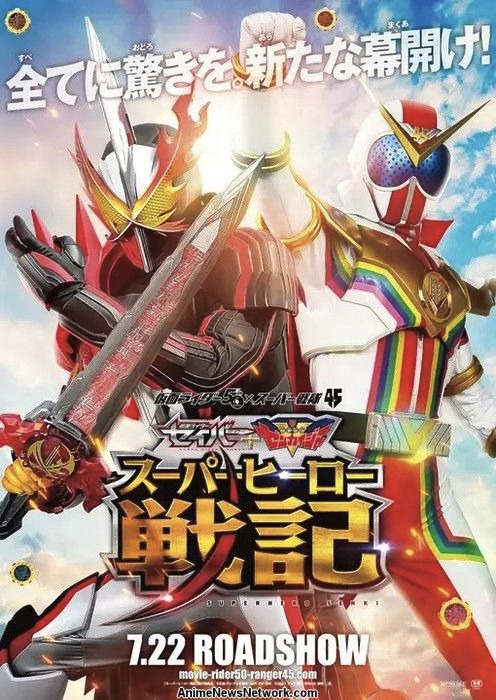
What Is Tokusatsu?
Tokusatsu is a genre of Japanese shows and movies that literally translates to “Special Effects”. Usually using a combination of monster or hero suits, practical effects like explosions, and light CGI.
That’s a REALLY wide net, so we’re just gonna focus on 3 shows today.
Super Sentai, Kamen Rider, and Ultraman. Thanks to @urotandersentai for drawing this neat little guide to the Visual Design of each of these 3 shows.
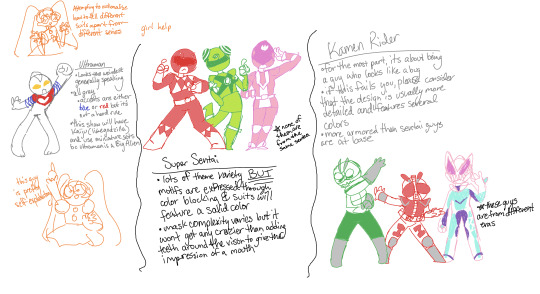
With that out of the way, let’s look at some individual seasons of these shows. Each one has a link to where you can watch it!
Please remember that at the end of the day, the best way to pick a show to watch is “Whatever looks coolest to you”. As such, I’ve included pictures!!!
Super Sentai

You might be saying, “This looks like Power Rangers!” And you’d be right!
Super Sentai, created by Shotaro Ishinomori and produced by Toei Productions, is kinda like Power Rangers’ Dad. PR has been using suits and even fight footage from Super Sentai to tell its own stories for 30 years. All this time, though, Sentai has been creating lovable and memorable casts of colorful heroes.
Generally, Super Sentai is about a team of heroes in colorful costumes that fight monsters every week to protect people.
There’s tons of shows in this series that are available FOR FREE.

CHOUJIN SENTAI JETMAN (1991)
The Earth is under siege from the Dimensional War Party Vyram. A special squadron is selected for an experiment to turn them into Super Humans with the powers of Birds, the Birdman Squadron Jetman. Vyram interferes with the experiment and kills all but one of the Jetman recruits. Instead, civilians are transformed and tasked with defending the Earth. The surviving recruit, Ryu Tendo, must convince 4 normal people with drastically different backgrounds to fight with him.
Jetman has the typical monster of the week format for Super Sentai, but when the team isn’t battling monsters, there’s some serious drama going on. The five of them are all drastically different individuals. It can make it hard to work as a team. Especially when it comes Black Condor. Dude’s a loose canon and an absolute bastard of a man.
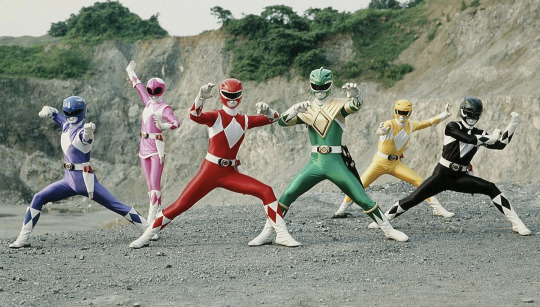
KYORYU SENTAI ZYURANGER (1992)
“From hundreds of millions of years ago, in the age of the dinosaurs, five warriors revive in the present time!”
When the Evil Witch Bandora awakens from her slumber, intent on terrorizing the Children of Earth, Five warriors from Dinosaur Times are unsealed to undo her schemes!
This one is where the suits for Mighty Morphin Power Rangers came from, which might tempt you to watch it first. I kinda recommend against that, though. It’s a fine show but I personally found it a bit boring. The characterization of the main cast didn’t stick out as much compared to other Sentai.
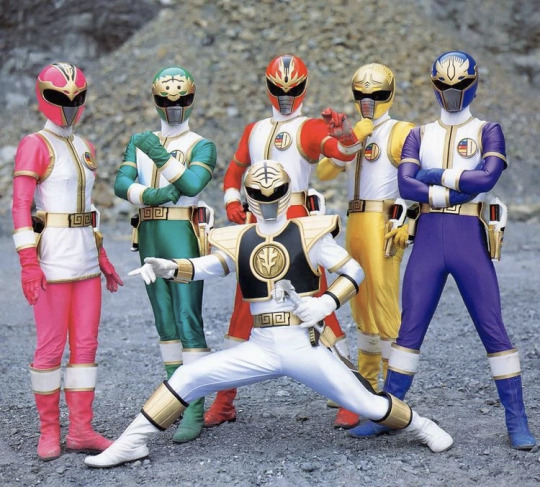
GOSEI SENTAI DAIRANGER (1993)
I haven’t seen this one, but it’s focused on martial arts and one of their mechs is a cool dragon? so uhhh? Check them out? Their theme song fucks
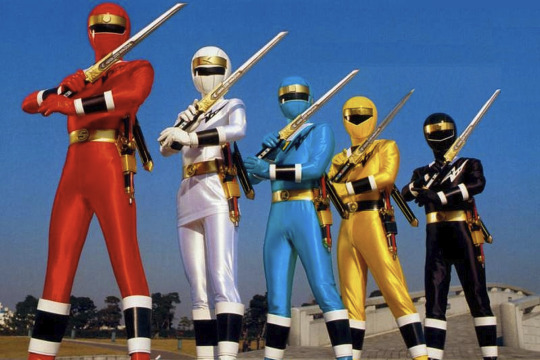
NINJA SENTAI KAKURANGER (1994)
Ok listen I didn’t watch this one either. HOWEVER, I know that it’s about the descendants of 5 legendary ninja who have been fighting yokai for 400 years.
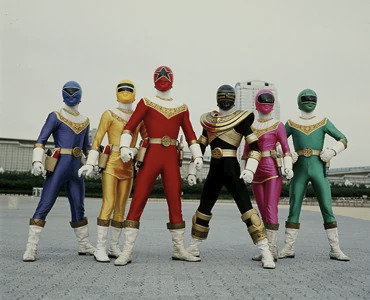
CHOURIKI SENTAI OHRANGER (1995)
This is the last sentai in the “I didn’t watch it” category. uhhh, watch it if the suits look cool. Sorry.
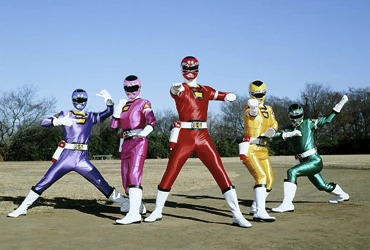
GEKISOU SENTAI CARRANGER (1996)
Five Mechanics use the power of Car Magic to protect the earth from the Universal Reckless Driving Tribe and teach children about Traffic Safety. This one’s a tad bit goofier compared to some of the others, but it’s a good time.
Also There’s a Yoda.
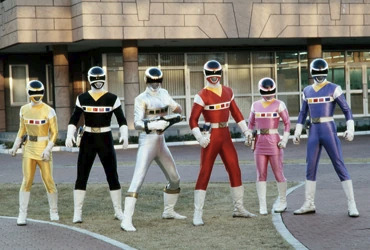
DENJI SENTAI MEGARANGER (1997)
Five High School Students are friends and pals! Together they investigate the mysterious goings on of a technologically advanced evil empire. They literally surf the net in order to bring peace to their city and the world!
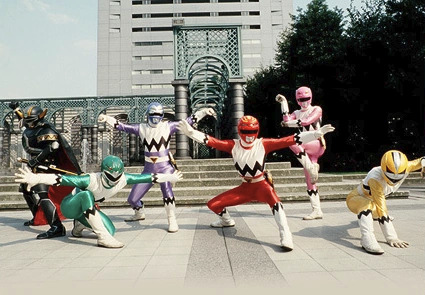
SEIJUU SENTAI GINGAMAN (1998)
The warriors of Ginga Forest, the Gingamen, have protected nature for 132 Generations. This series follows the 133rd Generation of Gingamen, who battle alongside Starbeasts to stop the resurrection of the Demon Beast Ditanix!

KYUKYU SENTAI GOGOFIVE (1999)
This time, the rangers are an experienced team of rescue workers given super human power! They fight back Literal Demons From Hell that endanger the public. There’s a lot of focus specifically on rescuing civilians in this one, so if you’re an especially big fan of watching heroes... SAVE people, this is a great choice.
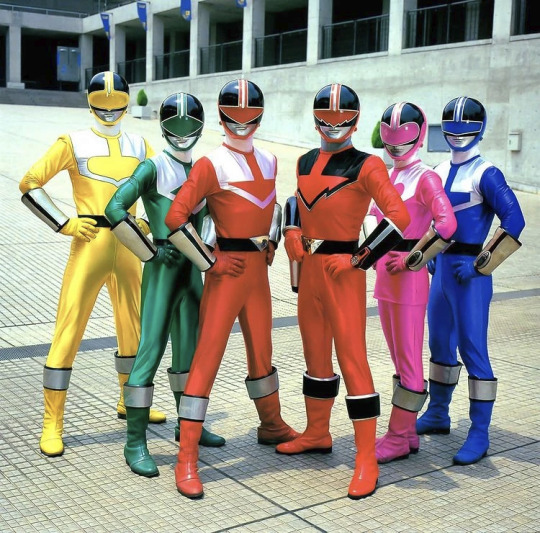
MIRAI SENTAI TIMERANGER (2000)
In the 30th Century, a gang of super criminals escapes to the year 2000. They are tracked down by the Future Sentai Timeranger, agents of the Time Defense Force. There, they encounter the Great(s) Grandfather of their departed leader and must convince him to fight alongside them for the sake of humanity.
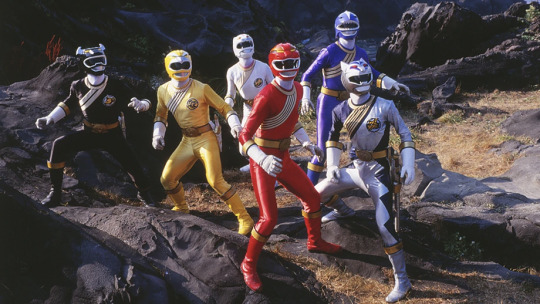
HYAKUJU SENTAI GAORANGER (2001)
Veterinarian Kakeru Shishi can hear the hearts of every animal! He swiftly becomes enraptured in the adventures of the Gaorangers, who battle living embodiment of pollution. Also they live on a flying turtle! How cool is that?
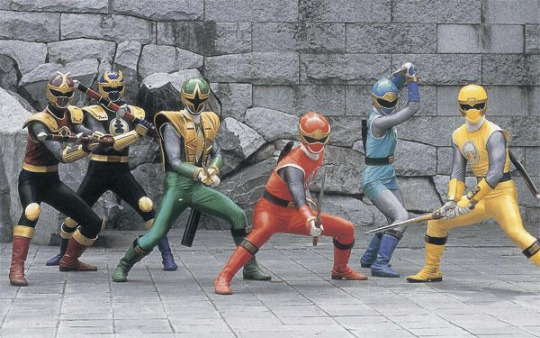
NINPUU SENTAI HURRICANNEGER (2002)
What if there was a polycule of ninjas SO BAD at being Ninjas, they showed up to Ninja Class Late and were the only survivors of an attack on their school? These guys are the silliest little slackers, but they’ve got hearts of gold. Check them out? For me? :)
KAMEN RIDER
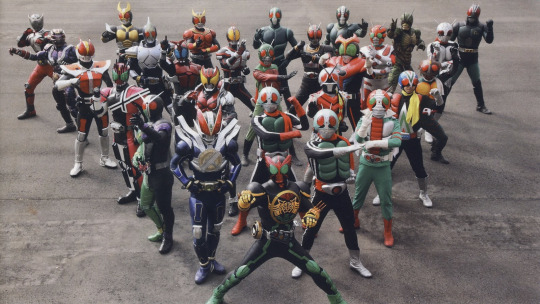
If Super Sentai is Power Rangers’ Dad, Kamen Rider is Power Rangers’ Uncle.
Kamen Rider was ALSO created by Shotaro Ishinomori.
Usually focused in on a smaller cast of heroes. A common theme in Rider is that the heroes are created by their villains and choose to rebel against them for the greater good, or will use the villain’s own powers against them.
Most Riders have a signature attack where they leap into the air and do a flying kick. These get INCREDIBLY flashy over the years.

Unfortunately, there’s a lot less Kamen Rider legally available than there are of the other two shows here. Don’t fret, it’s Easy Enough To Find Anyway.
As for the shows I can link you to, there’s
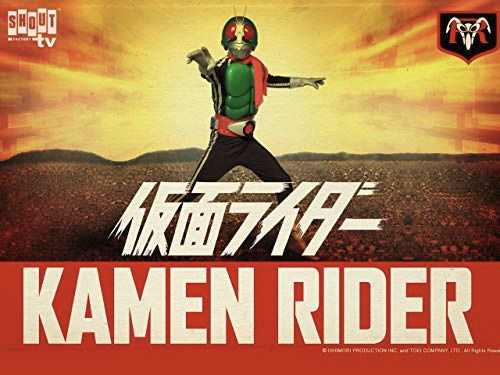
KAMEN RIDER (1971)
This is the original series.
Takeshi Hongo is an augmented human being created by the evil organization Shocker. Escaping before his brainwashing can be completed, battles for humanity’s freedom as Kamen Rider.
Being such an old show, the effects can be dated and cheesy. It’s a bit of an acquired taste, but if you stick with it, I’m sure you’ll love it. You can watch most of the show in almost any order. The only really confusing part is that eventually, Hongo tags out with fellow escaped cyborg Ichimonji Hayato as Kamen Rider. (This was due to a real world injury to Hongo’s actor during filming. Don’t worry, he’s still kicking and he comes back later in the show!)
It’s also the longest Kamen Rider show, so I don’t fault you if you decide not to watch ALL of it. Even I haven’t yet.
If reading is more your thing, it’s based on a manga that you can find a DELIGHTFULLY well crafted omnibus of here
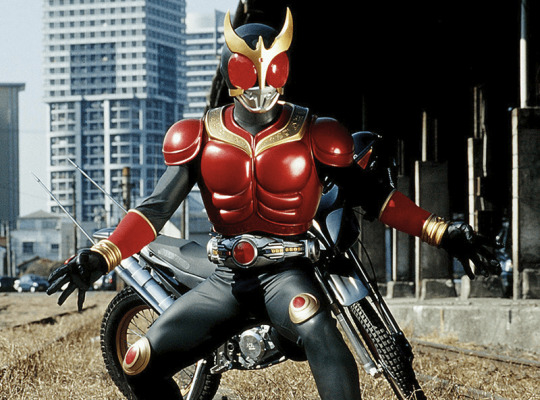
KAMEN RIDER KUUGA (2000)
Kuuga was the first season of Rider after about a 5 year break on TV. It’s something of a return to form.
It follows Yusuke Godai, a world traveler with 2000 skills, visiting his home town for the first time in years. He finds himself in the middle of an ancient civilization’s ritualistic murder game. Donning the mantle of Kuuga, Godai fights to protect the smiles of the city. He has a wonderful supporting cast around him including Detective Ichijou, who he goes on to share a rather homoerotic bond with.
Kuuga was my first Rider Series and to this day, it represents the Bread and Butter of Kamen Rider to me. This one’s a bit of a slow-paced Drama, but its focus is on what it means to help others. Every episode, I felt like I was actively being encouraged to be a better person. Godai’s got this infectious positivity that can’t help but make you grin.
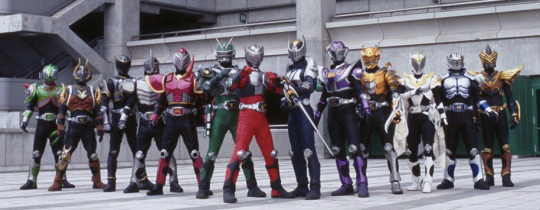
KAMEN RIDER RYUKI (2002)
Ryuki takes a rather different direction from the other shows on this list. Instead of being about a single hero battling monsters, it’s about Plucky Young Journalist Shinji Kido being wrapped up in an all-out war between Kamen Riders. Donning the mask of Ryuki, he seeks to put an end to the bloodshed. The other Kamen Riders aren’t nearly as cooperative, though.
Don’t think that this plot means these characters don’t get tons of humanizing moments though. They’re all delightful to watch in action and you’ll end up truly questioning who will win? Is it possible to end the Riders’ battle? Will Shinji have to take a life after all?
I cannot recommend Ryuki enough. A lot of the Rider series from the early 2000s are Dramas that feature super heroes and Ryuki takes that drama up to a 10. (Plus, if you wanna ask where to find it, there’s plentiful side content for this show.)

KAMEN RIDER ZERO-ONE (2019)
In the far-flung year of 2019, Hiden Intelligence has revolutionized AI technology. The company manufactures Robot Assistants called Humagears. People in all walks of life and profession benefit from their aid. Unfortunately, something is causing Humagears to go berserk and attack humans.
With the death of Hiden Intelligence’s president, Failed Comedian Aruto Hiden inherits the company. He’s given the Zero-One Driver, which allows him to fight the corrupted Humagears as Kamen Rider Zero-One. With this new power in hand, Aruto seeks a way forward where Humankind and AI can exist in harmony.
Come to think of it, this one’s kinda topical. “AI” is a subject we really aren’t gonna be getting rid of any time soon. This show is one of the more recent rider productions you can find legally and it SHOWS. Every suit is sleek and clean, the visuals are striking and flashy. If nothing else, Zero-One LOOKS incredible.
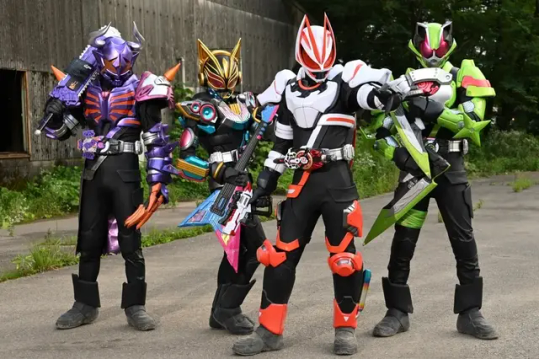
KAMEN RIDER GEATS (2022)
Kamen Riders compete in a game called the Desire Grand Prix. By fighting monsters and saving people for points, the winner can have their greatest desire granted. Ukiyo Ace, the titular Kamen Rider Geats, looks to unravel the mysteries behind the Grand Prix and reunite with his long-lost mother.
Things get a bit more complicated than that, but I think you should see it for yourself. I can’t recommend Geats enough. its visual style is a direct evolution of Zero One’s sleekness and flashiness. It’s main 4 characters are some of my favorites in recent years.
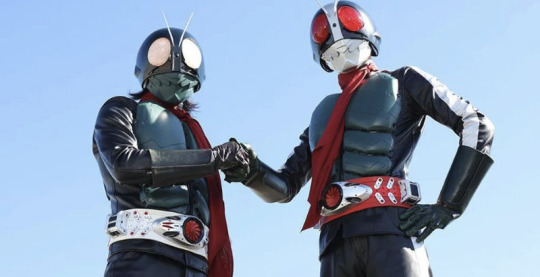
SHIN KAMEN RIDER (2023) (Paid)
Takeshi Hongo is an augmented human being created by the evil organization Shocker. Escaping before his brainwashing can be completed, battles for humanity’s freedom as Kamen Rider.
Wait, that sounds really familiar. That’s because this is the latest in a series of Tokusatsu Reimaginings by Hideaki Anno and Shinji Higuchi. This is a new take on the story of Kamen Rider 1971, modernized complete with sleeker suits and stunning music all wrapped up in a 2-hour movie. It also has plenty of Easter Eggs for those of us who are fans of the 1971 series or the Manga it’s based on!
Be warned, this one’s gorier than the other stuff on the list. It’s mostly exaggerated blood splatters, though. I hate that kind of stuff and I’m able to rewatch this movie.
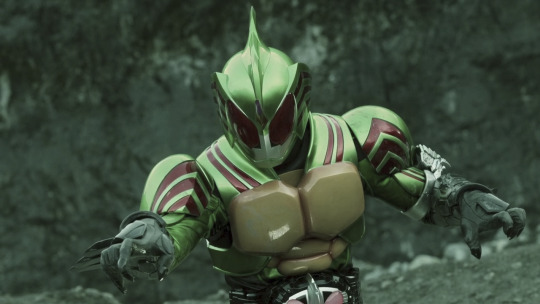
KAMEN RIDER AMAZONS (2016) (Paid)
Amazons is another adult reimagining of a classic Kamen Rider show, but it’s so far removed you don’t really need to know much about the original to enjoy it.
Amazons follows a group of exterminators who have been tasked with eradicating escaped cannibalistic experiments called, well, Amazons. The catch is that they work together with 2 Amazons, Momoru the Mole Amazon, and Haruka, the titular Kamen Rider Amazons. Both of them are tasked with asking themselves ethical questions. Is it so wrong for Amazons to exist? Is it possible to avoid eating people? If it isn’t, then is it WRONG to eat people to survive?
ULTRAMAN
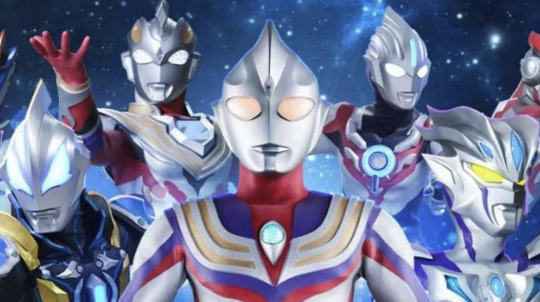
Ok, look, I’m gonna have to make a separate post covering all the free Ultraman stuff there is. Theres SO MUCH OF IT available that I don’t know where to start. We’re about to hit the image limit. If that post is done, it will be linked HERE.
But for a basic idea, there’s tons of stuff on Tubi and the official Ultraman Youtube Channel posts new episodes of the currently airing show.
#Tokusatsu#Kamen Rider#Super Sentai#Beginners Guide#Feel Free To Reblog This#I'm gonna pin it and updating it over time
98 notes
·
View notes
Text
Five underappreciated anime that I would recommend!
1. Canaan (2009)
This is, from what I understand, an adaptation of a side-story chapter for the visual novel series 428: Shibuya Scramble, guest-written by Nasu Kinoko and guest-illustrated by Takeuchi Takashi. That is to say, the Type-Moon guys — the creators of Tsukihime, Kara no Kyoukai, and the now-legendary Fate/Stay Night. However, Canaan doesn’t take place in the Type-Moon shared universe(s), since it’s for another company’s property.
That being said, the anime adaptation is quite comprehensible on its own terms, likely due to the adaptation being written by the prolific and highly skilled screenwriter Okada Mari (Hanasaku Iroha, O Maidens In Your Savage Season, Mobile Suit Gundam: Iron-Blooded Orphans, Maquia). Her writing imbues the narrative with enough emotional intensity to make up for the occasionally-convoluted nature of the plot, and the backstories of the characters are hinted at just enough so that the viewer can understand their relevance, without taking up too much precious screen time. It can be a little hard to follow at points, but I ended up understanding it decently well anyway.
The production values are very high indeed, due to the anime being produced by P.A. Works, and directed by Andoh Masahiro (Sword of the Stranger, Hanasaku Iroha, O Maidens In Your Savage Season). The action animation is consistently stunning, the characters are beautifully expressive, and the overall look of the show is fantastic.
And the voice acting is an absolute treat, with the lead role of Canaan herself taken by Sawashiro Miyuki, the antagonist role of Alphard taken by Sakamoto Maaya, and Nanjou Yoshino in the role of Oosawa Maria, the POV character for a lot of the story. The supporting voice cast is packed with talent too — Hamada Kenji, Tanaka Rie, Nakata Jouji, Tomatsu Haruka, Hirata Hiroaki, Noto Mamiko, and even Ootsuka Akio in a minor role!
The premise is sort of a science fiction type of thing, but set in the (quasi-)contemporary location of 2000s China, where outside of the sci-fi conceit, the setting is largely realistic. The tone and mood is mostly that of an action thriller, with some nail-biting suspense here and there, but there are some beautifully soft and tender moments as well — often involving Canaan and Maria. Yes, folks, this has yuri in it, although it’s (strongly) subtextual.
Anyway, I would recommend this to people who love Ghost in the Shell: Stand Alone Complex, Kara no Kyoukai, Fate/Zero, and probably also Cowboy Bebop.
2. Tetsuwan Birdy OVAs (1996)
This is distinct from the later adaptation of the original Tetsuwan Birdy (Birdy the Mighty) manga, called Tetsuwan Birdy Decode, which came out in the late 2000s — this one came out in 1996 and was produced by Studio Madhouse in their prime.
The main characters are Senkawa Tsutomu (voiced by Iwanaga Tetsuya), a hapless teenager who gets accidentally killed(!) by an alien spaceship on his way to school one day, and Birdy Cephon Altirra (voiced by Mitsuishi Kotono), a human-looking alien and an intergalactic government agent who saves Tsutomu by merging her body with his. Effectively, they become two people in one body, which can shift between the forms of Birdy and Tsutomu…. except Birdy still needs to deal with all the rogue aliens who threaten the safety of the galaxy, while Tsutomu needs to study for his high school entrance exams. From what I’ve been told, the premise is fairly reminiscent of Ultraman and other classic tokusatsu series.
It’s four tight episodes of classic ‘90s OVA goodness, with a fun and slightly silly sci-fi concept that is nonetheless wrung for some surprisingly effective drama at times. The main thrust of it, though, is action comedy — and it definitely delivers on that front. The fight scenes are superbly animated, including some early-career work from now-legendary animator Suzuki Norimitsu, and the character designs by Takahashi Kumiko (Witch Hunter Robin, Snow White with the Red Hair, Cardcaptor Sakura) are amazingly expressive. Birdy’s striking asymmetrical design is a particular favourite of mine. The direction by Kawajiri Yoshiaki (Cyber City Oedo 808, Ninja Scroll, Vampire Hunter D) is solid, and the writing is quite serviceable despite the brevity and premise.
Overall, I wouldn’t say it’s much of an intellectual watch, but if you just want a fun action-comedy ride with an extremely charismatic female protagonist and stunning animation quality, Tetsuwan Birdy is likely to be your jam. I’d recommend it to people who enjoy classic tokusatsu series, the original ‘90s Sailor Moon anime, and the less-depressing parts of Neon Genesis Evangelion.
3. Noir (2001)
This anime series is perhaps not as underappreciated as the others on this list, but I do still feel that not enough people have seen it. It was made by the studio Bee Train, and it’s the first entry in their so-called “Girls with Guns” trilogy (which isn’t actually a coherent trilogy, since they’re three different stories). The series was made right at the end of the cel-anime era, before the transition to digital colouring and compositing, so the masters were shot on film, but it was also made at the beginning of the slow transition to widescreen TV broadcasts, so it’s one of the very rare cel anime that’s in 16:9. This allows for a beautifully detailed look that, IMO, serves to offset the occasionally-limited animation and the frequent re-use of footage.
The premise is basically “secret assassins in France are caught up in weird intrigue and conspiracies”; as such, there’s a lot of very fun gunplay and kickass fight scenes, but also a lot of suspense and mystery. The writing is a little bit slipshod at times, but it ends up holding together, and the characters and (especially) the fantastically moody vibe make the show worth watching.
The characters are imbued with a lot of life and colour, both by their extremely attractive designs and by their voice actors’ wonderful performances. Mireille Bouquet, a young Corsican assassin and one of the two protagonists, is voiced by Mitsuishi Kotono; Yuumura Kirika, the other main protagonist who is a Japanese schoolgirl who has seemingly lost all her memories (but not her exceptional assassin skills), is voiced by Kuwashima Houko; and the mysterious Chloe, who shows up partway through the show, is voiced by Hisakawa Aya. There are definite yuri vibes between Mireille and Kirika, but as with Canaan, it’s all subtextual.
The main draw of the show, though, is its phenomenal soundtrack, courtesy of Kajiura Yuki (.hack//Sign, Kara no Kyoukai, Fate/Zero, Sword Art Online, Demon Slayer) in her very first anime scoring gig. It’s at times propulsive, at times dark and moody, at times beautifully serene, at times melancholy and nostalgic — and it’s utterly memorable.
I would recommend Noir to anyone who likes Canaan, Witch Hunter Robin, Ghost in the Shell, or anyone who just wishes that James Bond were a woman.
4. Flip Flappers (2016)
This anime was produced at Studio 3Hz and directed by Oshiyama Kiyotaka, in a dazzling yet underappreciated directorial debut that was presaged by his impressive animation work on Dennou Coil, Space Dandy, A Letter to Momo, The Secret World of Arietty, and The Wind Rises. Owing to this extremely solid animation background, Oshiyama was able to recruit a lot of prime animation talent for Flip Flappers, and it definitely shows in the stunning sakuga of the wild action sequences that pepper the show’s narrative.
While the fantastic animation is a key draw of this show, the sheer creativity in the worldbuilding, conceptual, and visual design spheres also contribute to its inimitably psychedelic look and feel. The landscapes of the worlds contained in Pure Illusion — the dream-realm that the protagonists enter each episode at the behest of a mysterious scientific organisation — and of the “real” world are whimsical, storybook-like, and slightly “off” in a slightly unsettling but compelling way.
The dreamlike atmosphere pervades the narrative as well — very little about the mechanics of the world is specified out loud, relying heavily on symbolism and visual storytelling to do the heavy lifting for the audience’s understanding. This might be a turn-off for audiences who prefer to have things spelled out for them clearly, but the point of this story is not always to make perfect logical sense, but rather to work on an emotional and metaphorical level. And work, it certainly does.
The episodic structure involving the various worlds of Pure Illusion explores the concept of the Umwelt (the individual sensory “world” of a person or organism), as well as some Jungian concepts and archetypes, in order to express the strange and sometimes-scary developmental stage of adolescence. The characters of Cocona (voiced by Takahashi Minami) and Papika (voiced by Ichimichi Mao) undergo a metaphorical and literal puberty, a coming-of-age similar in some ways to that experienced by the protagonist of FLCL, but with significantly more yuri. In fact, this show has the most outright yuri of any of the anime on this list. But that isn’t very strange for what is essentially a psychedelic magical-girl show: lots of magical-girl anime seem to include homoerotic vibes in some form or another, from Sailor Moon to Nanoha to Madoka.
There are some minor flaws in the storytelling towards the end, IMO, but overall it’s a wonderfully impactful emotional journey to watch Flip Flappers. Plus, the OP and ED are both extraordinarily catchy tunes that I’ve found myself humming on many an occasion.
I’d recommend this anime to anyone who loves weird magical-girl stuff, weird yuri, and/or amazing action animation.
5. Claymore (2007)
An adaptation of the manga by Yagi Norihiro, this anime is considered by many to simply be “basic”, or at least simply “inferior to the manga”. Now. I haven’t read the original Claymore manga (yet! I plan to eventually), but I found this anime to be compelling nonetheless. And if it really is the case that the manga is better, then I definitely look forward to diving in.
Having been produced by Studio Madhouse in the mid-2000s, it’s unsurprising that the vast majority of this anime was outsourced to Korean animation studio DR Movie, a longtime powerhouse subcontractor for both Japanese and American animation alike. That said, the direction of Tanaka Hiroyuki (director of a portion of Hellsing Ultimate and frequent close collaborator of Attack on Titan director Araki Tetsurou) remains sharp, compensating for the sometimes-limited animation with good storyboarding and a strong sense of mood and atmosphere.
Another aspect of Claymore which helps make up for the occasional visual shortcomings is the soundtrack by Takumi Masanori. The compositions are a mix of harder rock and electronic elements with a strong orchestral backbone, as befits a dark-fantasy setting and mood — the faster pieces are edgy and propulsive, very appropriate for the bloody action scenes, and the calmer pieces have a melancholic beauty to them that sticks in one’s memory. I wish the soundtrack were on Spotify, but alas, it is not.
The other sonic element that helps this anime out immensely is its absolutely STACKED voice cast. The main character, Clare, is voiced by Kuwashima Houko, in a fantastic yet understated performance. The other main character, Raki, is voiced by the less-well-known Takagi Motoki, but nearly all the other roles — including many bit parts — are filled with industry legends. Teresa is voiced by Park Romi, Miria is voiced by Inoue Kikuko, Irene is voiced by Takayama Minami, Rubel is voiced by Hirata Hiroaki, Priscilla is voiced by Hisakawa Aya, Ophelia is voiced by Shinohara Emi, and Jean (whom I cannot help but ship with Clare: there’s so much homoerotic tension there!) is voiced by none other than Mitsuishi Kotono. Yes, they got three of the original Sailor Senshi VAs — and I don’t know why that’s funny to me, but it is. And all of the voice actors deliver killer performances.
The premise of the show, before I completely forget to explain it, is that of a dark fantasy world where demons called youma ravage human settlements, with only the titular Claymores to protect humanity. They are a guild of platinum-haired and silver-eyed warrior women who possess superhuman fighting abilities, due to the fact that they’ve been fused with youma essence, and wield the massive broadswords that give them their name. Basically, (s)he who fights monsters must become (partly) a monster to do so.
I’ve heard the vibe of Claymore compared to manga like Berserk, and I don’t know how true that is (not having read the latter for myself), but there’s certainly a lot of bleakness and monstrosity in this fantasy tale. However, the Claymore manga was published in none other than Weekly Shounen Jump, so it’s perhaps unsurprising that the story remains resolutely forward-looking, the protagonists’ arcs focussing on the power of grit, determination, true friendship and loyalty, and protection of the weak and downtrodden. It’s never cynical or sarcastic — always straightforward and sincere despite the frequent darkness of the story.
The writing is consistently solid, even through the controversial anime-original ending (the manga continues long past the point where the anime cut things off), so I’m not sure who to point to for that: Yagi Norihiro for writing the original material, or Kobayashi Yuuko (JoJo’s Bizarre Adventure, Attack on Titan s1-3, Kakegurui, Casshern Sins) for adapting it cleanly for the screen? Either way, it made me want to read the manga to experience more of these compelling characters and their travails.
I would recommend this anime to those who enjoy Kill La Kill or RWBY, or just to those who enjoy powerful women hacking at monsters with massive weapons and making lots of blood spray out.
#anime recommendation#anime recs#flip flappers#tetsuwan birdy#birdy the mighty#claymore#noir#noir 2001#canaan#long post#personal#anime
125 notes
·
View notes
Text

I do get a little sentimental when I watch said Ultraman Christmas ad. It features a young Nadia Gifford singing the Wham! song "Last Christmas". Here's her cover in full. Simply adorable. (No More Heroes & Steambot Chronicles fans might know her work)
It's one of several ads by Tsuburaya from the 90s that features the Ultraman family, as well as their alien & kaiju enemies celebrating Christmas. They were sorta like those Sainsbury or John Lewis store Christmas ads.
For whatever reason, some of these ads ship Ultraman with his enemy Dada. Lady Dada isn't bad. She was just born this way (Sorry, I just had to).
Here's some more of them.
円谷プロCM 90年代
TSUBURAYA Merry Christmas (1997)
[平成CM・1996年]ウルトラなクリスマス
Here's some similar ads from the era. I don't think these are Christmas ads, but I would be remiss not to include them.
【なつかCM】円谷プロ ウルトラマン カネゴン
1995年CM 円谷プロ ウルトラマンレーシング 日本ビジネススクール専門学校
円谷プロ CM
ブースカ スノーボード
#ultraman#ultraman memes#Seinfeld#jerry seinfeld#seinfeld memes#george constanza#Nadia Gifford#christmas memes#90s ads#90s commercials#90s japan#pigmon#booska#ultraman kaiju#ultraman aliens#christmas commercials#christmas ads#tokusatsu#ウルトラマンクリスマス#ウルトラマン#ultraman Seijin#ダダ#ultra kaiju#円谷プロダクション#Tsuburaya#となりのサインフェルド#ナディア・ギフォード#last christmas#alien dada
7 notes
·
View notes
Text







春川 芽生は、日本の女優、モデル、声優。身長169cm。スリーサイズ 87-63-88cm。大阪府出身。スターダストプロモーション所属。 第13回ニコラモデルオーディショングランプリ。元『nicola』専属モデル。 2020年11月、スターダストプロモーション制作3部から声優部へ移動した。 ウィキペディア
生年月日: 1996年8月11日 (年齢 27歳)
出生地: 大阪府
身長: 169 cm
TV/映画: うまゆる、 Ultraman Trigger、 シンデレラゲーム、 さらに表示
血液型: O型
���
110 notes
·
View notes
Text


Happy Birthday to Konomi Naito & Himena Tsukimiya!
They share the same birthday month, with just two days apart! Konomi Naito (18 Nov 1994) & Himena Tsukimiya (16 Nov 1996)
Pics : Ultraman Wiki & himenachaaaaan
#konomi naito#naito konomi#himena tsukimiya#tsukimiya himena#ultraman blazar#japan#japanese actress#tokusatsu
9 notes
·
View notes
Text
after much deliberation and going to several stores, i did decide to get ANOTHER piece of ultraman merch.
this time it’s something i normally wouldn’t have picked at a first glance.
it’s a baltan piggyback


he’s a lot brighter then he looked in the display

here’s a size comparison.
I actually like that he is super vibrant and for a second hand figure, he is in very good condition. There’s only like two little black scuffs on his head. But his paint job is basically still intact.
(he’s from 1996 or at least that’s what the copyright on the bottom says)
14 notes
·
View notes
Video
tumblr
Ultraman: Legendary Giant of Light (SIMS / Bandai - Sega Saturn - 1996)
16 notes
·
View notes
Text

this is really funny. ultraman from 2021 vs ultraman from 1996 the boob growth has been crazy
16 notes
·
View notes
Note
Never seen ultraman
What should I watch first to see if I like it or not?
Ultraman is a tokusatsu series with a very large variety of tones and styles. Each season is distinctly different from the last, especially in the New Generation era. Some seasons are very serious and gritty, some are slice-of-life, and some are light plot/heavy action. It's up to you on what you'd prefer!
I want to preface with the three eras (and sub eras) of Ultraman, just so you're aware of these terms when they come up:
Showa (1966 - 1987)
Heisei (1996 - 2012)
-> Heisei Trilogy/Part 1 (1996-1999)
-> Heisei Part 2/Phase 2 (2000 - 2012)
New Generation (2013 - Present)
-> Reiwa (2019 - Present)
That being said, I give you 5 equally valid options to begin:
Option 1:
Ultraman (1966)

Start with where it all began!*
Ultraman (1966) is Japan's take on the Twilight Zone but with a superhero-esqe twist. If you enjoy older sci-fi like the early seasons of Doctor Who or the first Star Trek, you'll greatly appreciate the practical effects, deep but episodic plots, and the unique kaiju/seijin.
From there, watch in order of release and enjoy just how much the show evolves. All the highs and lows.
*(Side note - technically Ultra Q (1966) is the first show but does not feature Ultraman whatsoever. This show serves as a prequel to the idea of kaiju and seijin in the modern world. If you're a completionist, you can start here and be amazed at how there are *still* monsters and plots making reappearances from this show)
Option 2:
Ultraman Tiga (1996)
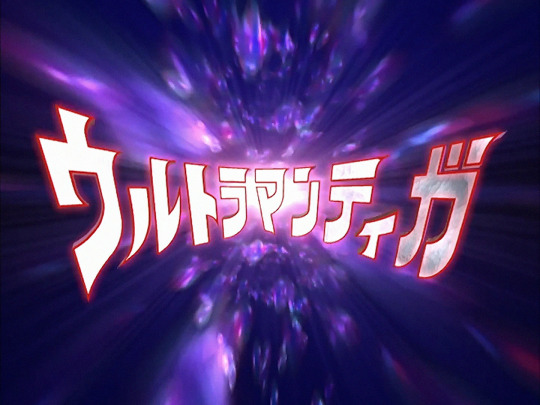
Ultraman Tiga is the beginning of the Heisei Era and is widely regarded as one of the best series in the entire franchise.
I have lots of love to give to Tiga specifically, and this post of mine explains why that is:
Option 3:
Ultraman Mebius (2006)
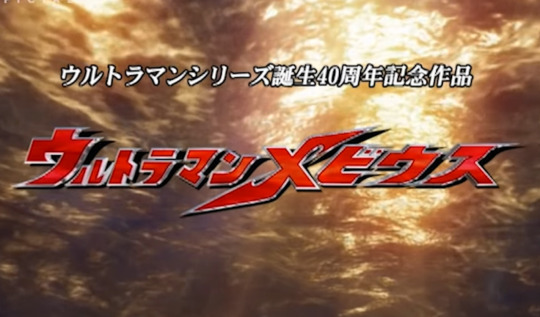
Ultraman Mebius is the 40th anniversary of the Ultra series and is a beautiful continuation and love-letter of the Showa Era timeline. It features returning cast members, monsters, and plotlines from Ultraman, Ultraseven, Jack, Ace, Taro, Leo, and 80 (which all take place on the same Earth).
This show is a perfect introductory piece to the series because it exposes you to such a large amount of lore from the past while recontextualizing it with modern effects, richer storytelling, and a more serious tone. Mebius has so much heart, happiness, and hopefulness. It's a very positive and "heroic" type show.
Option 4:
Ultraman Orb (2016)
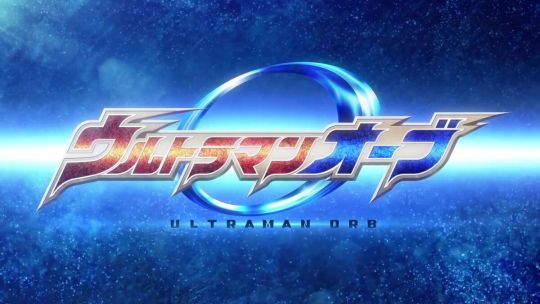
Ultraman Orb is, even while nestled in the near-middle of the New Gen Era, a fantastic starting piece and my typical recommendation for starters. It's quite fun and light-hearted but has an intense emotional core surrounding lost love and a broken friendship. The action and special effects are top-notch, and the main villain is an ICONIC character who pops up many times in later shows.
This show introduces fusions, which become a frequent New Gen trend (Orb does it the best of all). Great choice if you're looking to get dropped somewhere not too confusing or plot-intensive yet still action-y and engaging.
Option 5:
Ultraman Blazar (2023)
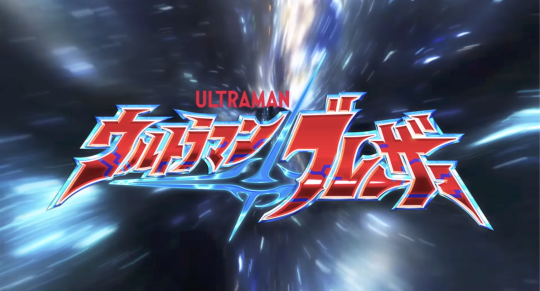
Ultraman Blazar is the newest season of Ultraman and started airing back in July. As of writing this, we are currently at Episode 8.
Blazar is unique and inventive so far in both its plot and aesthetic. It has a semi-serious sci-fi/military feel mixed with amazing new kaiju and.... a really strange Ultra lol. Blazar is unlike most thus far. He's primitive and beastly, kinda like a caveman.
It may not be the most completely accurate representation of the series as a whole, but nothing beats the excitement of watching the newest season as it airs!! The Tsuburaya official YouTube channel simulcasts each new episode as it airs in Japan (with japanese or english audio and subs).
~
I wish you luck on your multiverse-spanning Ultraman adventures!
Feel free to ask more questions if you have any 💛💛💛
50 notes
·
View notes
Text
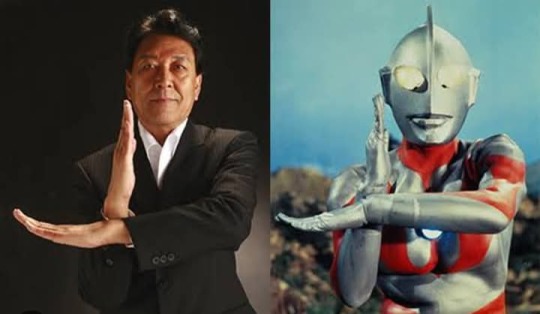
Satoshi Furuya (古谷 敏さとし, Furuya Satoshi),known professionally as Bin Furuya (古谷 敏びん, Furuya Bin),
is a Japanese actor best known
for his portrayal of the title character
in the 1966 series Ultraman.
Furuya would later portray the character Amagi in the sequel series Ultraseven.
Furuya has also made appearances in Mothra (1961), Gorath (1962), High and Low (1963), Ghidorah, the Three-Headed Monster (1964), Ultraman Zearth (1996), Mega Monster Battle: Ultra Galaxy (2009), and Shin Ultraman (2022).
5 notes
·
View notes